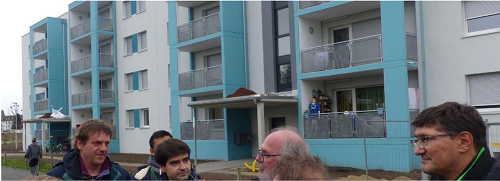April 5, 2020
How social housing can be realised in an energy efficient and cost-effective way
Low operational costs for heating and electricity and a high standard of living comfort are possible at the same time: the latest session of the Research Group for cost-effective Passive Houses addressed the issue of social housing and how it can be implemented in a cost-effective and energy efficient manner.
During an associated excursion, many participants visited the PassivhausSozialPlus in Darmstadt, Germany which is a nationwide model project for social housing. Many municipalities, particularly in high-density urban areas, are tackling the urgent task of providing more affordable housing. Although government subsidies are often available for energy-efficient buildings, investments in energy efficiency especially are perceived to be a major factor for increased costs by the property developers.
"Generally speaking, it is not enough to only consider the investment costs for construction. The auxiliary costs are of crucial importance for socially acceptable rents," explains Oliver Kah of the Passive House Institute. The session of the Research Group on social housing initiated by the Passive House Institute dealt with both cost segments. Dr Wolfgang Feist, founder of the Passive House Institute, has pointed out that energy efficient housing construction helps in achieving climate protection objectives."Noticeable success has already been achieved through better energy efficiency. These solutions must now be applied with commitment."
Social housing to the Passive House standard: the incidental costs for the PassivhausSozialPlus in Darmstadt, Germany, aim for two Euros per square metre, including the budget for electricity and hot water, greywater utilisation and internet. The Research Group for cost-effective Passive Houses and the subsequent excursion during the Open Days focused on this nationwide model project.
During the 55th Session of the Research Group for cost-effective Passive Houses, Esther Gollwitzer of the Passive House Institute identified the saving potential and cost drivers for housing construction. Based on the example of already realised multi-storey residential buildings, she showed that the construction costs fluctuate considerably even with the same energy standard. This might be due to different building designs, for example. However, Gollwitzer emphasised that energy efficiency measures have only a small impact on the total costs of the building and mentioned that these additional costs amount to about four to seven per cent for building to the Passive House standard.
For more information on Passive House Institute, visit www.passiv.de

An 18-apartment building in the Passive House project is rented out for a monthly amount of just 5 Euros per sq m to cover costs, including heating
Energy efficient buildings are attractive for residents

|
|
Copyright © Building.hk All rights reserved.
|
|


